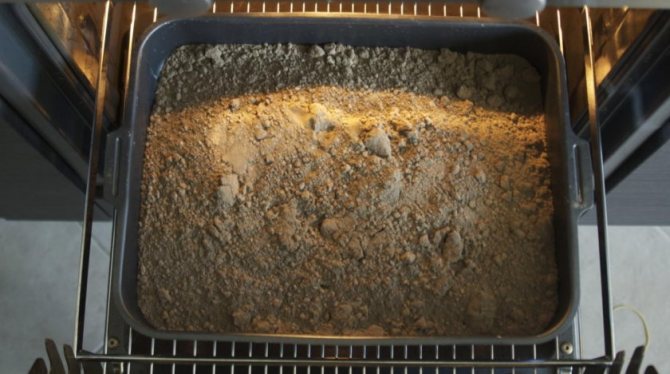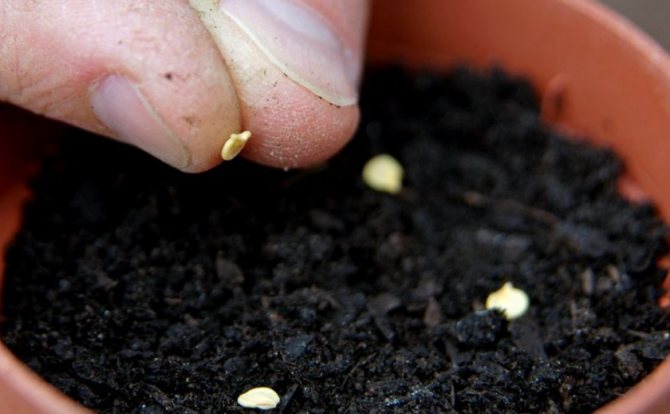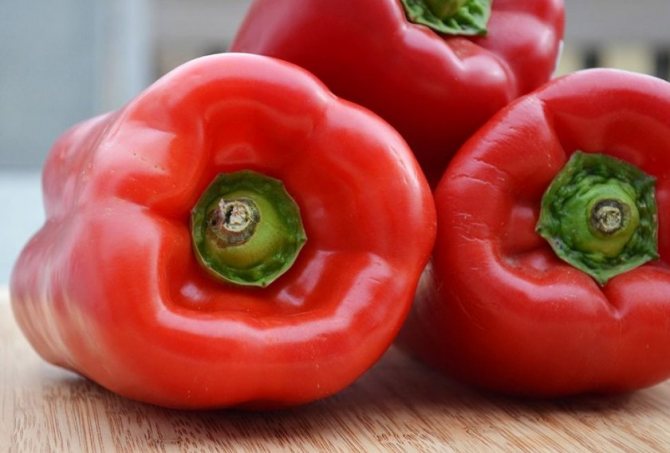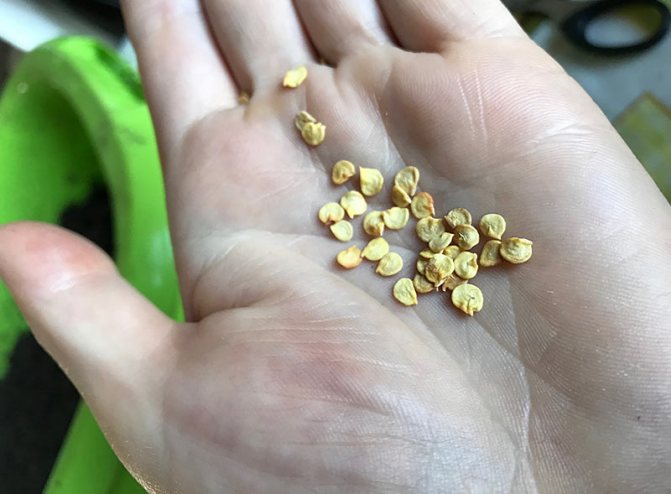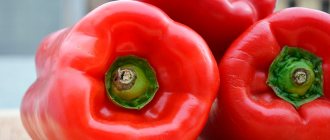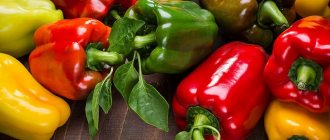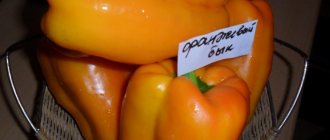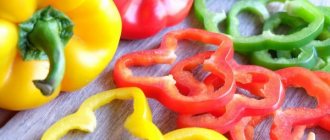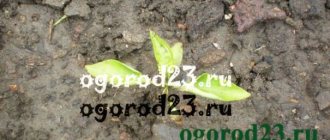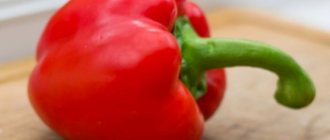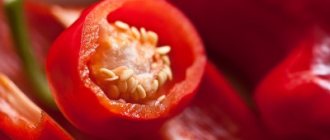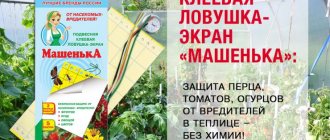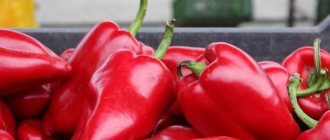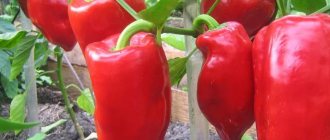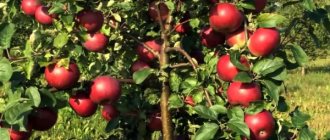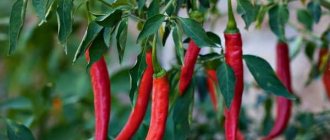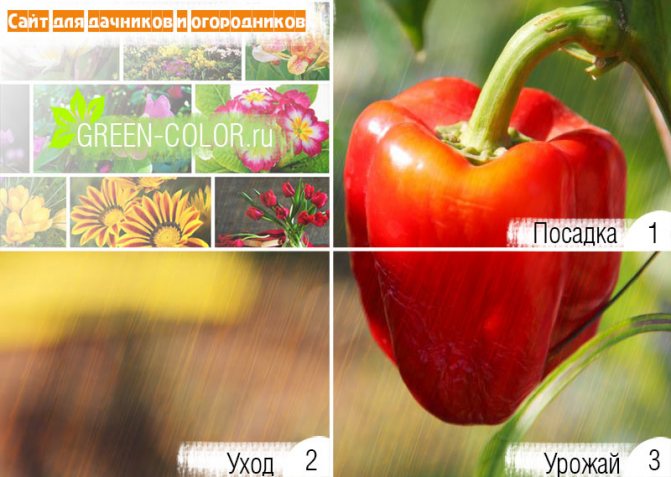
Bell peppers come in a variety of colors. The main ones are green, yellow, orange and red. Sweet pepper Fatty refers to those varieties that are on a par even with recently bred hybrids, since it has a large number of advantages and is able to please even an inexperienced gardener with a rich harvest. But this is feasible only when the agricultural technology of growing this crop is observed. The following is a detailed description of the variety: characteristics, cultivation features, yield, reviews.
Description of the variety, reviews, photos
Mid-season, high-yielding, thick-walled sweet pepper variety for open ground and film tunnels. The period from germination to the beginning of ripening is 115-118 days.
The bush is semi-spreading, 50-55 cm high. The formation of the plant consists in the removal of all lateral shoots and leaves until the first fork. The leaf of this pepper is medium-sized, green, wrinkled.
Fruit characteristics
Fruits are drooping, prismatic, slightly ribbed, glossy, at the stage of maturity, red, weighing 130-200 grams (according to gardeners' reviews, they are often much larger), juicy, excellent taste without bitterness. Fruit length 10-12 cm, diameter 6.5-8 cm, wall thickness 5-10 mm. These peppers are distinguished by good transportability. They are universal in use - suitable for fresh consumption, home cooking, and are also good for canning.
Productivity of pepper Fat man: 4-4.5 kg of fruits per 1 sq. meter of planting (in the presence of watering and dressing).
Features of growing, planting and care
Sowing pepper seeds for seedlings is carried out 60-70 days before planting the plants in a permanent place. The optimum temperature for seed germination is 26-28 ° C. When landing in the ground for 1 sq. m place 5-7 plants.
Pepper is planted in the ground without deepening, but in exactly the same way as it grew in cups. Pepper plants, unlike tomatoes, very rarely give lateral roots, so there is no point in deepening.
The bell pepper variety Fattyachok responds well to watering and feeding with complex mineral fertilizers.
Sweet pepper Fatty is included in the State Register of the Russian Federation.
How to shape pepper, video
Stepsons take a lot of energy from the plant, so they need to be removed as early as possible. When pinching, the lower leaves also need to be cut off, then it will be more convenient to water the plants, apply top dressing, and loosen the soil.
If you have grown Fatty sweet peppers, please write whether you like this variety or not. What was the yield in your climatic conditions? How do you rate the resistance of this variety to diseases? If possible, attach a photo of the pepper you have grown to your comment. Thank you!
Your reviews about Fatty Pepper and additions to the description will help many gardeners evaluate this variety more objectively and decide whether to plant it or not.
Sweet Pepper Care Fat Man
How to plant seedlings in open ground? First of all, before planting, it is necessary to warm up the soil by covering it with a film. Pepper is a thermophilic plant, therefore it reacts poorly to cold and coolness. For a successful landing, it is important to follow some rules.
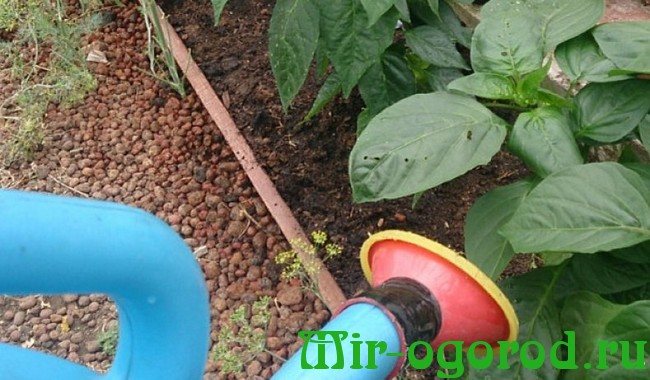

The Fatty variety needs regular watering every 3-5 days. 1 bush takes about 2 liters of water.In a dry and hot summer, water the vegetable daily, but make sure not to overmoisten the soil. Excess water leads to the formation of rot and other dangerous diseases. The appearance of the plant requires attention. If the leaves begin to curl, then the plant needs moisture. Experts recommend watering your bushes early in the morning to avoid sunburn.
The next mandatory stage of care is loosening the beds. It not only improves the flow of oxygen to the roots, but also helps to get rid of weeds. It is better to loosen the soil after watering, going 5-10 cm deep. If the soil is too hard and dense, then loosen it more deeply. The procedure is carried out after each watering and rains. Row spacings also need regular weeding. When the bushes begin to bloom, sprinkle the stems with loose, slightly damp earth.
Also, sweet peppers are regularly fed with mineral complexes or organic fertilizers. The first feeding is organized after 15 days, potassium-phosphorus compositions or liquid bird droppings are used. In 10 l of water add 50 g of superphosphate and 10 g of potassium chloride. In total, during the ripening period, the pepper is fed 3-4 times. Especially the vegetable needs nutrition during the period of fruit formation. Plants are fertilized with ash or the Zdraven mineral complex.
Sweet pepper Fat is one of those varieties that are on a par even with recently bred hybrids, since it has a large number of advantages and is able to please even an inexperienced gardener with a rich harvest. But this is feasible only when the agricultural technology of growing this crop is observed. The following is a detailed description of the variety: characteristics, cultivation features, yield, reviews.
Description of the variety, reviews, photos
Large-fruited, thick-walled, beautiful and productive variety of Siberian selection with fruits of a rare orange blossom.
A bush up to 80 cm high, with a closed bush that hides a large number of tied fruits, in technical ripeness coinciding in color with dark green foliage.
Fruit characteristics
On the bush, up to 15 large, cubic fruits weighing up to 300 grams are formed, with a wall thickness of up to 10 mm, the number of nests is 3-4. The thick-walled fruits, free of the bitter substance capsaicin, have a pronounced peppery aroma, sweet taste and delicate texture. Peppers of the Siberian Bonus variety are able to ripen well, practically without losing their elasticity.
The variety is recommended for cultivation in greenhouses and open field. Suitable for fresh consumption and any kind of processing.
The yield of pepper Siberian bonus. up to 3 kg per plant (with proper agricultural technology).
To increase the yield, it is recommended to observe the regime of mineral nutrition and irrigation, to collect fruits that have reached technical maturity in a timely manner.
Agrotechnics of cultivation, planting and care
Sowing pepper seeds for seedlings is carried out 60-70 days before planting the plants in a permanent place. The optimum temperature for seed germination is 26-28 ° C. When landing in the ground for 1 sq. m place 5-7 plants. The Siberian bonus variety responds well to watering and feeding with complex mineral fertilizers.
If you have grown Siberian Bonus sweet peppers, please write whether you like it or not. What was the yield under your conditions? If possible, attach a photo of the entire bush or individual fruits.
Your reviews about Siberian bonus pepper, as well as additions to the description, will help evaluate this variety more objectively and decide whether to plant it or not.
Thick-walled peppers
The homeland of sweet pepper is the same as that of bitter: Central and South America. There it is a perennial and essentially maintenance free weed. In more northern regions, it is grown as an annual.
In the CIS, sweet pepper is called Bulgarian, although there is no such definition anywhere else in the world, even among the Bulgarians themselves. The secret of such a unique phenomenon is revealed simply: warmer Bulgaria was the main supplier of this southern culture to the USSR.
Over the past hundred years, the active spread of sweet pepper in the world culinary, more than 1000 varieties of this vegetable have been bred. Moreover, a special variety of pepper varieties has emerged in the last thirty years. If back in the eighties of the last century, bell peppers were only yellow, red or green (the technical stage of ripeness), now you can choose a pepper of almost any color.
The color of the peppers ranges from almost white to almost black. There are dark brown, lilac, purple, two- and three-colored peppers.
According to the purpose, modern varieties of sweet peppers are divided into:
- for salad;
- for conservation;
- for salting;
- for drying;
- for freezing;
- for stuffing.
Red giant
A mid-season variety characterized by a high yield (7-8 kg per bush). Differs in large fruits of a cuboid type (20 x 10 cm), red-raspberry color with fleshy walls (thickness 6-10 mm). The mass of one fruit is 250-300 g. The fruits are distinguished by high taste: the taste of the Red giant pepper is sweet, rich. The fruits are good both for fresh consumption and as part of a variety of preservation.
Red giant Red giant pepper, seeds
The bushes of the plant are powerful, up to 1.2 m high. The yield of the "Red Giant" is up to ten fruits per bush. This type of pepper is adapted for open ground, but is also suitable for greenhouse cultivation. The optimal planting scheme for bushes is 70 x 40 cm. Seedlings are planted 70-80 days after germination.
Photo of the Red Giant pepper
The variety shows the highest yield on loamy soils with good air permeability. During the growing season, fertilizing of the bushes with mineral fertilizers is mandatory.
To increase germination, the seeds are soaked in a solution of potassium permanganate and washed abundantly with water.
Top rot
On pepper, this disease does not appear on the top, like in tomatoes, but on the lateral surfaces of the pod. Liquid-filled areas appear first, later these areas enlarge, becoming black / brown, leathery and dry. Gradually, the affected surface becomes concave. Sites can be up to 8 cm in size. Diseased peppers ripen prematurely and can be re-infected with pathogenic fungi.
Reasons for the appearance
The disease occurs when there is a lack of calcium in the fruit. The plant cannot provide the fruits with a sufficient amount of calcium with sharp fluctuations in soil moisture (drought / waterlogging), with an excess of nitrogen in the soil, or with damage to the roots during the loosening process.
A warning! Top rot prevention is one of the reasons for the requirement to carefully loosen the soil under the pepper, since the root system of the plant is very close to the surface.
A combination of too high temperature (more than 25 degrees) and low air humidity (less than 50%) is also very undesirable. This combination usually occurs in early spring, when monthly peppers are very sensitive to these factors, and the daily temperature drops are very large.
- Temperature and humidity control in greenhouses.
- Regular watering to prevent the soil from drying out, but without waterlogging.
- Spraying plants with calcium nitrate.
Pests and diseases
Most often, the development of diseases is observed when the cultivar agrotechnology is not followed. Also, this indicator is negatively affected by the lack of disease prevention.
The most common diseases:
- Blackleg. Causes of the lesion: excessively dense planting of plants, high soil moisture, sudden temperature changes.
- Stolbur.External changes: leaves turn yellow, dry up; the fruits are deformed.
- Late blight. Shoots and fruits become covered with dark spots and quickly disappear. The disease is contagious and quickly spreads to neighboring plants.
Sweet pepper pests are another major problem. Most often it is attacked by aphids and slugs. The first settles on the back of young leaves, where they drink the juices of the plant. The bush quickly withers and stops bearing fruit. Slugs love to feast on the juicy pulp of the fruit.
Popular varieties and hybrids of thick-walled peppers for cultivation without a greenhouse
In total, there are over 1000 varieties and hybrids of sweet peppers. However, not all have received real popular recognition. Only the most delicious, fruitful and unpretentious ones have gained universal love and respect. Some of them are presented below, the distinctive feature of which is the thick wall and the possibility of growing in the open field.
It is one of the most sought-after sweet peppers for many reasons. It is resistant to many diseases, ripens early and has good yields. The fruits are characterized by a pleasant aroma, juiciness and are suitable for any purpose. Each of them has an average weight of about 150 g and a wall thickness of 0.9 cm. Many people like their spherical shape.
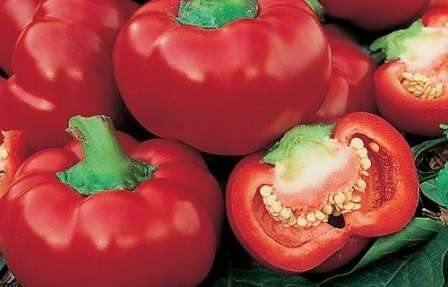

Pepper Gingerbread Man
This name was given to him for a reason, since the mass of one fruit can reach 300-400 and even 600 g. The walls are fleshy, up to 1 cm thick; there is sweetness in the taste. The red giant belongs to the mid-season varieties, and the height of the bush reaches one meter. The yield is good - about a dozen peppers are harvested from the bush. This is one of the most prominent representatives of his family.
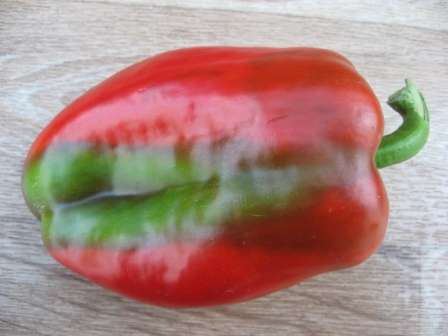

Red giant
This pepper bush is suitable for growing both outdoors and in a greenhouse. It reaches a meter in height, but is strong enough not to need to be tied up. Up to 15 peppers can be harvested from one plant. The California miracle belongs to the mid-season varieties, has an excellent aroma and a wall thickness of about 5 cm.
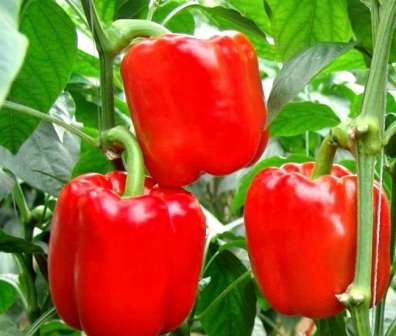

California miracle
This variety belongs to the mid-season group and is suitable for outdoor and indoor cultivation. The plant grows to a height of about 50 cm and needs to be shaped by pruning. The taste of the fruit, which can reach a weight of 130 g, is highly appreciated, the wall thickness is about 1 cm. They are particularly well tolerated during storage and transportation.
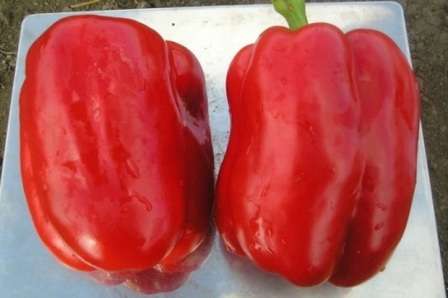

Fat man
This sweet pepper may be one of the first on the kitchen table, but its aroma is very gentle, barely noticeable. Unusual sunny color of fruits, which sometimes weigh half a kilogram. Bugai is convenient to grow in the open field, as the bushes grow strong and low. Peppers keep well after harvesting without losing their original appearance.
The fruits are dark red in color, excellent taste, thin peel, have an average weight of 250 g and a wall thickness of 1 cm. Anastasia belongs to standardized hybrids, therefore, its height is limited to 60-80 cm. Ripening is medium early sweet pepper.
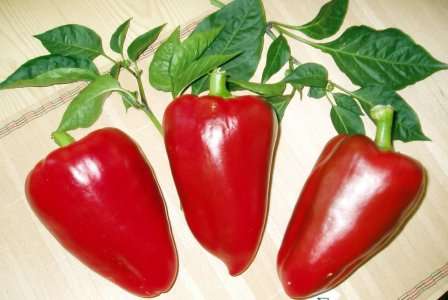

Anastasia
This thick-walled sweet pepper has the usual red color, but a rather unusual shape, which explains such an interesting name - it is thin and elongated (up to 20 cm in length); average weight - 150 g. It is grown both in the open ground, and in a greenhouse, and under a film, on the table it appears one of the first. The pulp is juicy, up to 0.8 cm thick. The cow's ear has shown itself to be quite resistant to many diseases and well tolerated during transportation.
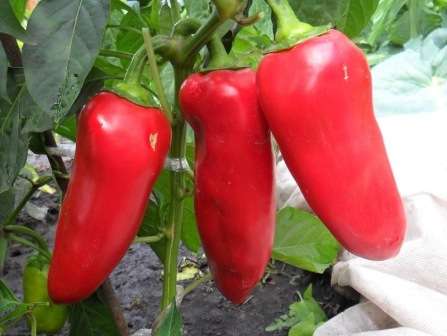

Cow's ear
Very tasty thick-walled pepper, with an average weight of 200 g and a wall thickness of up to 0.7 cm. It is grown for processing and fresh consumption. Refers to mid-season varieties. Forms a strong compact bush, not too demanding to care for. Well suited for cool summer conditions.
The fruits of this thick-walled sweet pepper (pulp thickness 0.6-0.8 cm) have universal application, are distinguished by a pronounced aroma, and their weight can reach half a kilogram. The variety is mid-season.
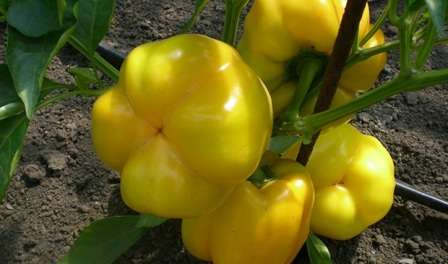

Sun of italy
The considered varieties of thick-walled sweet peppers for open ground are not the limit of the entire assortment. There are many other varieties of this crop that have thick flesh and are suitable for outdoor use. However, the above varieties are most in demand, which means that it is best to start with them. Most likely, after that you will no longer want to conduct experiments on your site.
Read also: When to dig out garlic: harvesting and storing garlic
California miracle
One of the most popular mid-season sweet pepper varieties among domestic summer residents. The variety has remained in demand for many years due to its bright sweet taste and high concentration of vitamin C in the fruit. At the stage of full ripening, the peppers have a cuboid shape and a scarlet color.
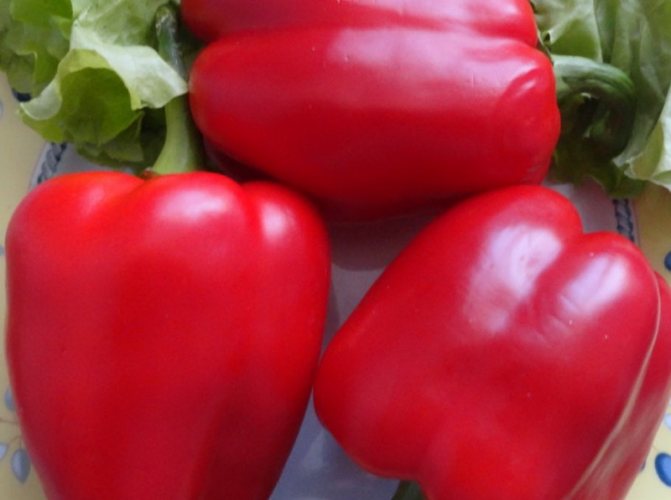

California miracle
Fruit characteristics:
- pericarp - 6-8 mm;
- length - up to 8cm;
- width - 6-7 cm;
- weight - 130-150 g.
Adult plants reach 0.7 m in height, the branches are strong, resilient, not requiring tying. You can get 12-15 fruits from one plant. At the same time, the pepper does not require special care conditions; regular watering and replenishment of the soil with basic mineral fertilizers is sufficient.
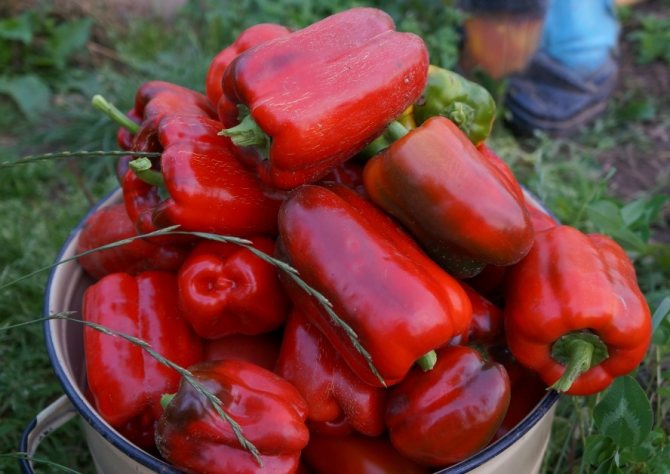

California miracle pepper
Like previous varieties, the California Miracle is grown by seedlings. Planting in open ground is carried out 2, -2.5 months after germination, in early June. The optimal planting scheme is 40 x 45 cm. The first feeding is done in 10-12 days.
For normal growth and productivity of pepper, it is important to maintain a moisture balance in the soil. The plant is sensitive to drought, but stagnant water also harms it
Sweet pepper "California miracle" red
Varieties of thick-walled sweet peppers with photos and descriptions
With the right selection of varieties of thick-walled sweet peppers for your summer cottage, you can provide your family with tasty and healthy fruits for the whole year. These are amazingly delicious all kinds of canned salads and sauces, first and second courses with the addition of pepper, stuffed, fried, pickled and fresh peppers. Sweet peppers that came to us from Central America are not quite suitable for the weather conditions in Russia.
In harsh climatic zones, preference is mainly given to early, early-maturing and mid-season varieties. At the same time, early ripening varieties have the best yield. Later varieties are grown for harvesting. Breeders have tried to create low temperature resistant, unpretentious varieties of different colors with a wonderful taste. You can harvest a bountiful harvest only by seedling, followed by planting in open ground or in a greenhouse of varieties of pepper suitable for the conditions of your climatic zone. Read on for more details.
Pepper varieties for dachas in Belarus
Breeders have developed excellent varieties of thick-walled sweet peppers for Belarus. Summer residents of the Gomel and Brest regions today have the opportunity to grow thick-walled peppers in the open field, collecting a good harvest. In other areas, pepper is best planted under a film.
- Of the early varieties, the Alesya and Boogi varieties have proven themselves to be excellent. Bushes of short stature give amazing tasty fruits with a wall thickness of 7-8 mm. You can use dark green peppers during technical maturity or wait until they are fully ripe and have a bright red color.
- Red and yellow "Cube" gives a wonderful harvest on the Belarusian soil. The taste of the fruit leaves no one indifferent. The weight of one pepper can reach 250 g. Lecho of yellow and red varieties has an unusual taste, which was appreciated by gourmets. The crop can be transported over long distances and stored.
- Thick-walled pepper varieties "Parnassus" refers to mid-season varieties. Fruits in the form of a cube or heart of large sizes, when ripe, acquire a yellow-orange color. Walls up to 10 mm thick are dense, fragrant and have good taste. Suitable for fresh and canned consumption.
- The Master hybrid is distinguished by its endurance to disease damage and temperature extremes. When fully ripe, the fruits acquire a rich red color. Cone-shaped peppers are good for stuffing, canning and adding to salads.
- Mid-season varieties "Bogatyr", "Spartakus", "Red Knight", "Golden Rain" when grown in greenhouses give a higher yield than in open beds. Taste good, but the size of the fruit is smaller than that of the early peppers. Perfect for making sauces, rolling salads.
Fetal characteristics
Thick-walled hybrids (varieties) are distinguished by high productivity, for which summer residents and farmers love them. The main distinguishing characteristic of this type of sweet pepper is the pericarp thickness of 8 mm. An important characteristic of any variety is the ripening period in days:
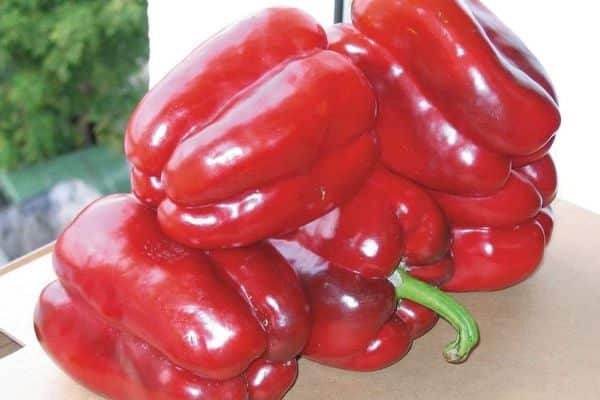

- early to 100;
- mid-season up to 120;
- late to 150.
Pods that have reached technical ripeness (light green, dark green, cream) are well stored. Duration of storage of juicy, fleshy fruits that have reached biological ripeness is shorter.
The pod of any thick-walled variety reaches its maximum weight with high agricultural technology. The colors of thick-walled peppers that have reached biological ripeness depend on the particular cultivar.
Thick-walled peppers in the dachas of the Moscow region
Minerals and vitamins contained in the pulp of sweet pepper have a difficult positive effect on the human body, and are one of the best components of a natural pharmacy. This is one of the reasons to learn how to grow a heat-loving vegetable in closed and open beds. A little theory, effort, investment and very soon the first yellow, green, red and even purple juicy fruits will appear on the table.
Summer residents of the Moscow region have a large selection of sweet pepper varieties for growing in their beds. Fruits differ in color, shape, weight.
The most popular early varieties of thick-walled sweet pepper for the Moscow region:
- The golden-white "Fidelio" ripens just 90 days after germination. The fruits are large. The owners will be pleased with the high harvest.
- The bright orange variety "Orange Miracle" will delight you with its excellent harvest and beautiful large fruit weighing up to 250 g.
- From bright green to purple-red, the fruits of the varieties "Rhapsody" and "Winnie the Pooh". The first is resistant to diseases, and the second is distinguished by a friendly harvest, storage duration.
- For cultivation in greenhouses choose "Semko" and "Agapovsky". Wonderful varieties of excellent taste and beautiful-looking fruits will decorate the table.
- Beautiful elongated fleshy fruits at the "Atlantic". It has proven itself well in indoor and outdoor cultivation.
Of the mid-season varieties of thick-walled sweet peppers, I would like to highlight the “Gift of Moldova”, “Golden Rain” and “Volzhanin” peppers. The fruits are slightly less in weight, but tasty with a bright color. The harvest is surprisingly stable and the peppers are not afraid of any diseases.
There are a lot of varieties suitable for growing in summer cottages of the Moscow region, and you cannot plant all of them in your beds. Try to plant "California Miracle", "Bulgarian 79", "Fat Bag".
Sweet peppers in the suburban areas of Siberia and the Urals
Today it is possible to grow a decent harvest of sweet pepper even in the harsh conditions of Siberia. To do this, you will have to build a small greenhouse or provide plants with plastic cover for the night and on cold days.
Choosing thick-walled sweet peppers for Siberia and the Urals is necessary from the most unpretentious varieties that take root in cold regions:
- The early ripe "Kolobok" is distinguished by small green fruits and a compact bush. The vagaries of nature are not a hindrance to getting a bountiful harvest.
- The bright green and red color of "Montero" is suitable for eating fresh, fried, stuffed, rolled up.
- "Edino" is extremely unpretentious and is able to please a summer resident of any climatic zone.
- Large yellow "Sylvia" will decorate the table and will surprise you with its taste.
- Low bushes "Topolin" will endow the owners with large dense fruits weighing up to 150 g.
- In the mountainous areas of the Urals, such varieties of early toasted peppers as Kubyshka, Kudesnik, Sonata, and Barguzin delight summer residents with a good harvest.
- The mid-season "Swallow" is suitable for open and closed cultivation.
- The pyramidal fruits of the "Firstborn of Siberia" are good for stuffing and preservation. It showed itself excellently in any growing conditions.
- For harvesting for the winter, you should plant "Victoria" and "Gift of Moldova".
- Juicy small fruits appear in abundance on the bushes of the "Purple Star of the East", "Zaznoba", "Marabou".
- The bright red color of the "Gambler" variety will please you with its delicate pulp.
- The fragrant, thin-cored fruits of the mid-season "Alyosha Popovich" have proven themselves well both in blanks and on the table. Experts call this variety a versatile variety.
Read also: Cabbage Ankoma F1: description, photos, reviews
When choosing pepper for your site, you should take into account its qualities:
- Give preference to hybrids, early and mid-season varieties.
- The sweeter the pepper, the more valuable it is.
- Productivity from one bush is important for small planting areas. It is also better to reduce the financial issue and labor costs.
- The larger the fruit, the more pulp and vitamin.
- Thick-walled peppers taste different from thin-walled peppers.
- For seaming, it is better to use fruits of different colors. The salad looks especially beautiful.
- For open planting, choose undersized bushes. Tall plants are suitable for greenhouses.
To help you choose the best varieties, we have compiled photographs of the thick-walled sweet pepper varieties described in our article.
A selection of photos of the best varieties of thick-walled peppers
- Variety "Player"
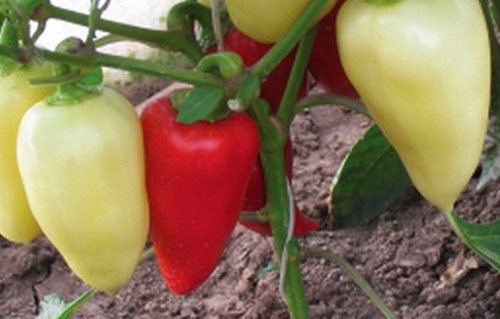

- Variety "California miracle"


- Variety "Zaznoba"
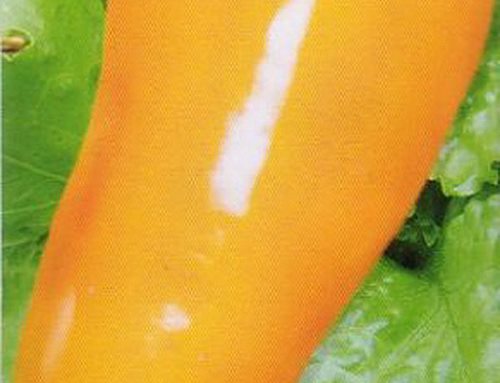

- Variety "Agapovsky"
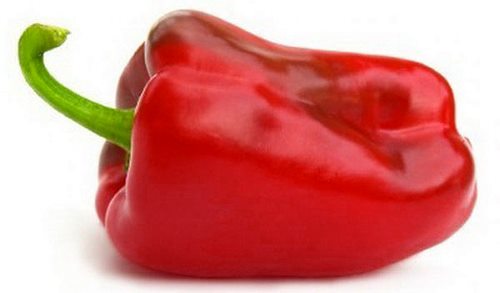

- Variety "Yellow Orange"
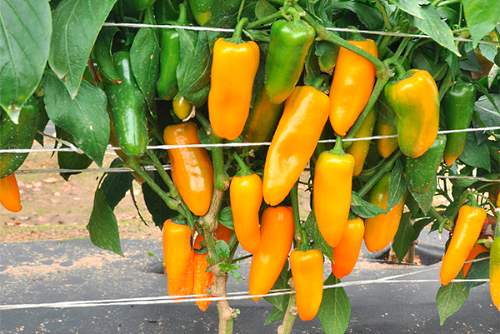

- Variety "Golden rain"
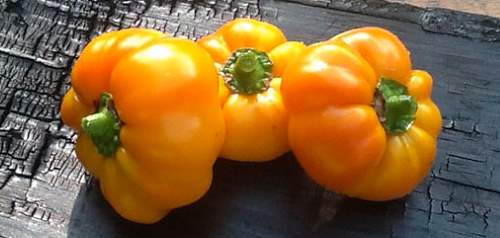

- Variety "Swallow"
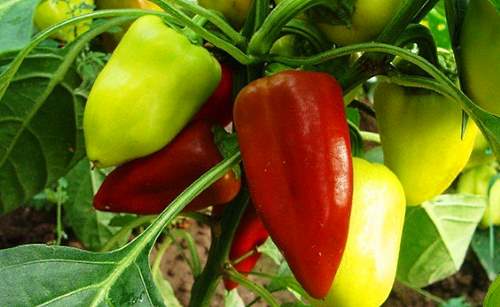

- Variety "Kolobok"
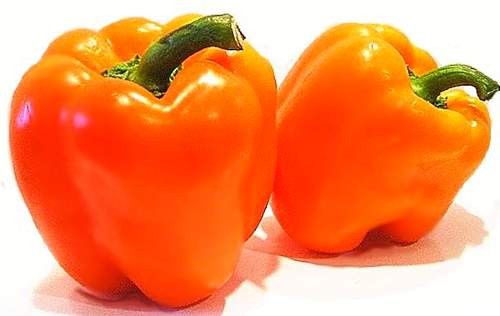

- Variety "Semko"
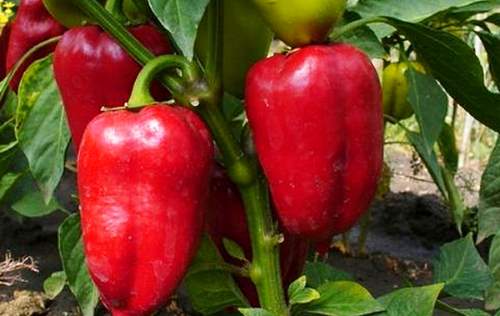

- Variety "Topolin"


- Variety "Purple Star of the East"
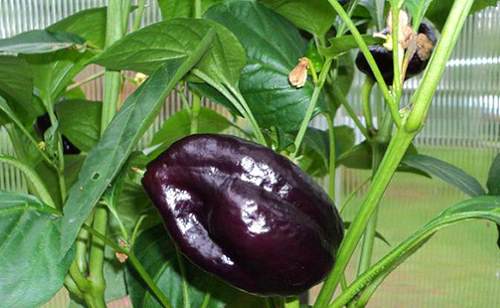

Video about choosing a pepper variety for growing
Features of the
Pepper is a treasure. A vegetable contains a huge amount of nutrients. Here is some of them:
- Vitamin C, which protects the body from the effects of stressful situations, ensures the harmonious functioning of the body and helps to better absorb calcium and iron.
- Vitamin A, which enhances immunity, improves vision and balances the body's regenerative work.
- Vitamin PP is a drug. This substance is generally extremely difficult to find in natural products.
Growing bell peppers is not as difficult as it sounds. There are so many varieties out there, so picking the pepper you like is easy.
Early varieties
Early outdoor peppers and hybrids grow very well. Do you think that you will not be able to grow meaty and juicy foods?
You're wrong. The main thing is to understand the varieties of pepper. First, let's figure out what is the difference between hybrids and varieties.
Hybrids are the fruits of crossing. They perfectly combine the best features of the parent plants, but are not capable of producing seeds.
The varieties are the result of choosing the best seeds. The variety is like a parent plant like two drops of water, moreover, it is capable of producing offspring.
The best way to choose a variety or hybrid of thick-walled peppers is to look closely at the seed packaging.
If you are looking for super early sweet peppers, check out this list of the best super early peppers and hybrids of thick-walled peppers:
- Bugai is a super early variety.Peppers with thick walls, but with a mild taste, but ripening occurs faster than other varieties. The wall thickness is about 1 cm.
Pepper variety Yellow bell
- Yellow bell. The wall thickness is about 1 cm, the height is up to 12 cm, and the mass of one pepper is about 100 g.
- Gingerbread man - a bush up to 60 cm tall, the fruit of which reaches 150 g. This variety is excellent for conservation.
- Eskimo F1 is a hybrid plant that has a wall thickness of about 8 mm and a bright, beautiful red color.
If you need a variety that is not just very early, but also early maturing, then we present to your attention a list of varieties that ripen in record time:
- Belladonna F1 is a hybrid that has a record yield, and ripens in 55 days from the moment of planting.
Pepper variety Big Papa
- Topolin is perfect for stuffing and has an increased yield.
- Albatross - matures in 45 days and is suitable for consumption raw. The variety is capable of a very high quality and succulent harvest.
- Big Mama is one of the most popular varieties. Possesses excellent taste and is distinguished by large fruits, which weigh about 200 g. Also, this variety is the proud owner of a wonderful orange color.
- Big Papa is a purple variety that is highly resistant to various diseases of peppers.
- Candy is a variety that will delight lovers of decorative gizmos. Has a compact size, but thick walls. The fruit weighs only 40-50 g.
Read also: Tomato Logane F1: description, photos, reviews
Czardas
Czardash pepper is a fruitful, early ripening variety: technical ripeness comes on the 95-100th day, biological ripeness on the 115-125th day from the shoots. The bush is a defining type of bouquet, compact, with a height of 60-70 cm. Fruits have a conical shape, directed downward in different directions, weighing 170-220 g, measuring 13-16 × 6.5-8 cm, the thickness of the pericarp is 5- 6 mm.
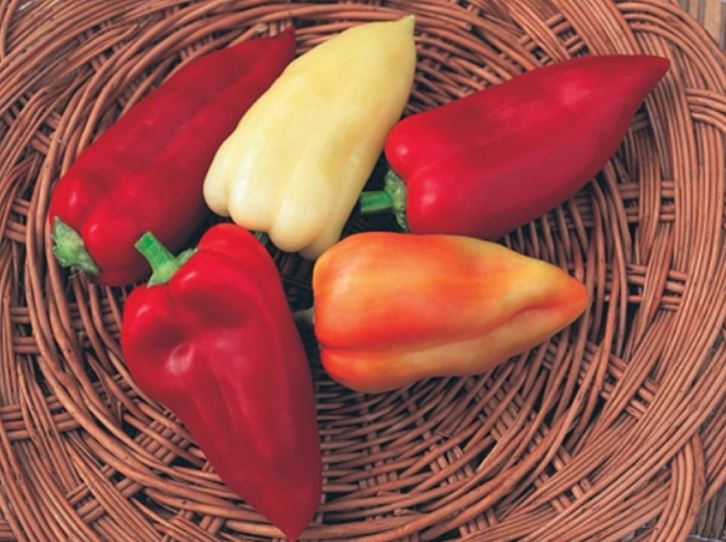

Arrangement of fruits and leaves - bouquet (bunches). Fruits of technical ripeness are yellow-orange, in biological maturity they are orange-red. The fruit is very decorative and effective, suitable for use at any stage of development.
Thick-walled Bulgarian varieties
Pepper variety Swallow
There are insanely many varieties of sweet peppers that are intended for outdoor use.
But not all of them are reliable and will definitely give the expected result. You should be very careful when choosing planting material for your beds.
We would like to present to your attention a list of varieties of bell peppers that have won the love of summer residents and deservedly have the status of the most reliable and suitable for any growing conditions:
- Swallow is a variety that is one of the most popular among summer residents. It differs in that it can lie for a long time, while maintaining its taste. The swallow has a wall thickness of up to 1 cm.
- Ural thick-walled - the name of this hybrid speaks for itself. The thickness of the walls of this fruit can exceed 1 cm, and the length of the peppers reaches 18 cm. The hybrid is very resistant to all sorts of diseases.
- Dunyasha is an incredibly interesting variety of pepper. The fruit is cube-shaped and tastes great. Peppers weigh up to 200 g.
- Fat Baron is a variety that is popular for its reliability. Although it is not a hybrid, it is excellently resistant to viruses.
- Jupiter F1 - the variety has a weight of up to 180 g, a very smooth surface. It differs in that it has a small coating of wax on the surface.
- Czardash is famous for the fact that the fruits can be consumed at any stage of ripening. The variety is decorative.
So we've covered the very best and most proven varieties of chunky peppers suitable for outdoor use that are guaranteed to appeal to you.
Among the varieties listed above, you will find a favorite for yourself and will not regret your choice at all, because this article contains only the best varieties and hybrids.Now is the time to talk about how bell peppers should be grown.
Preparing seedlings of the Fat Baron
The center of origin of sweet pepper is Mexico, therefore, in the middle lane and to the north, there is a danger of freezing of plants, and the best way out is to cultivate it in film greenhouses. "The Fat Baron" was bred in the Pridnestrovian Research Institute of Agriculture, which testifies to his significant whimsy in relation to the temperature regime.
Pepper cultivation in all regions is carried out through seedlings, which begin to be practiced in February-March. Presowing seed preparation includes:
- disinfection with 1% solution of potassium permanganate or "Fitosporin";
- treatment with a growth stimulator ("Epin-extra", "Zircon", aloe juice);
- between damp cotton pads placed in a plastic container to prevent moisture loss.
Pepper belongs to crops that react very painfully to picks that damage the delicate root system, therefore, the seeds that have grown are immediately placed in peat tablets. The sprouts are provided with warmth, abundant lighting and systematic watering. The seedlings are ready when they have at least 10 leaves.

